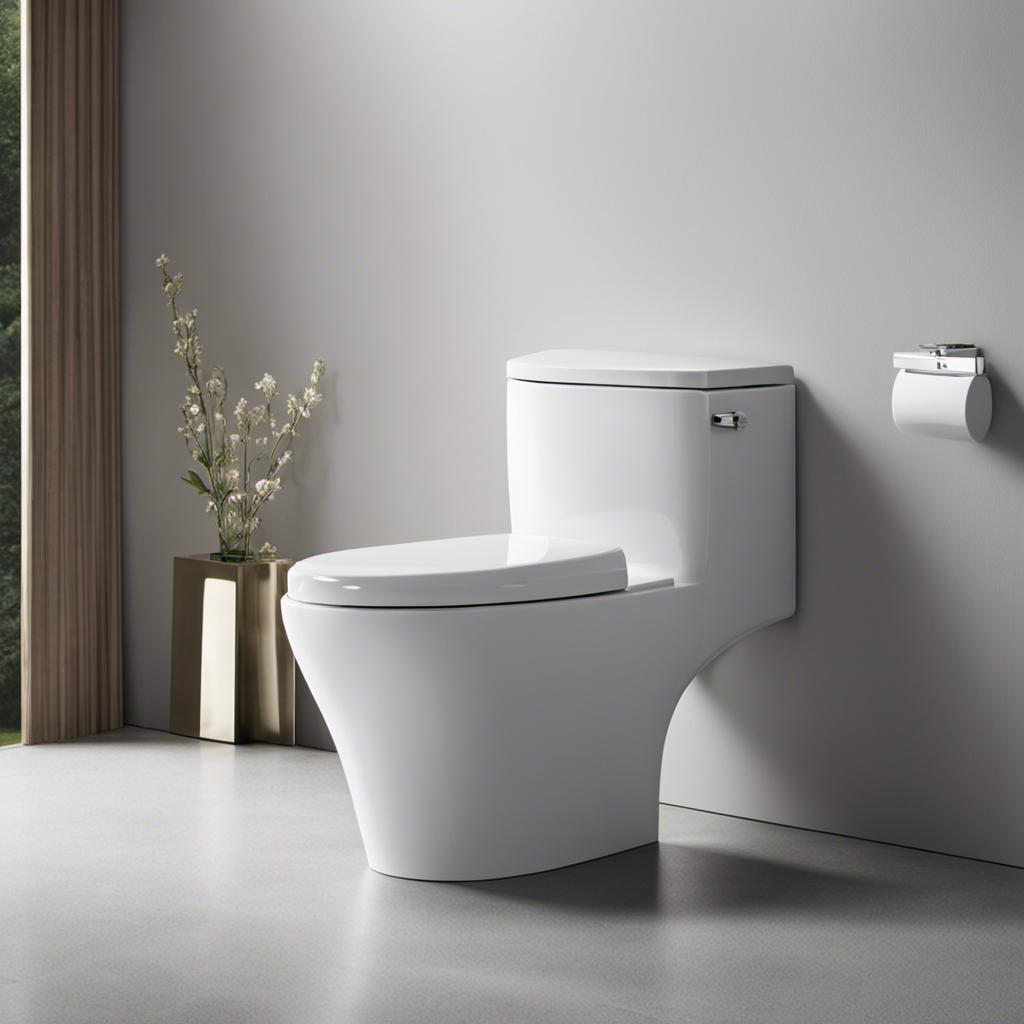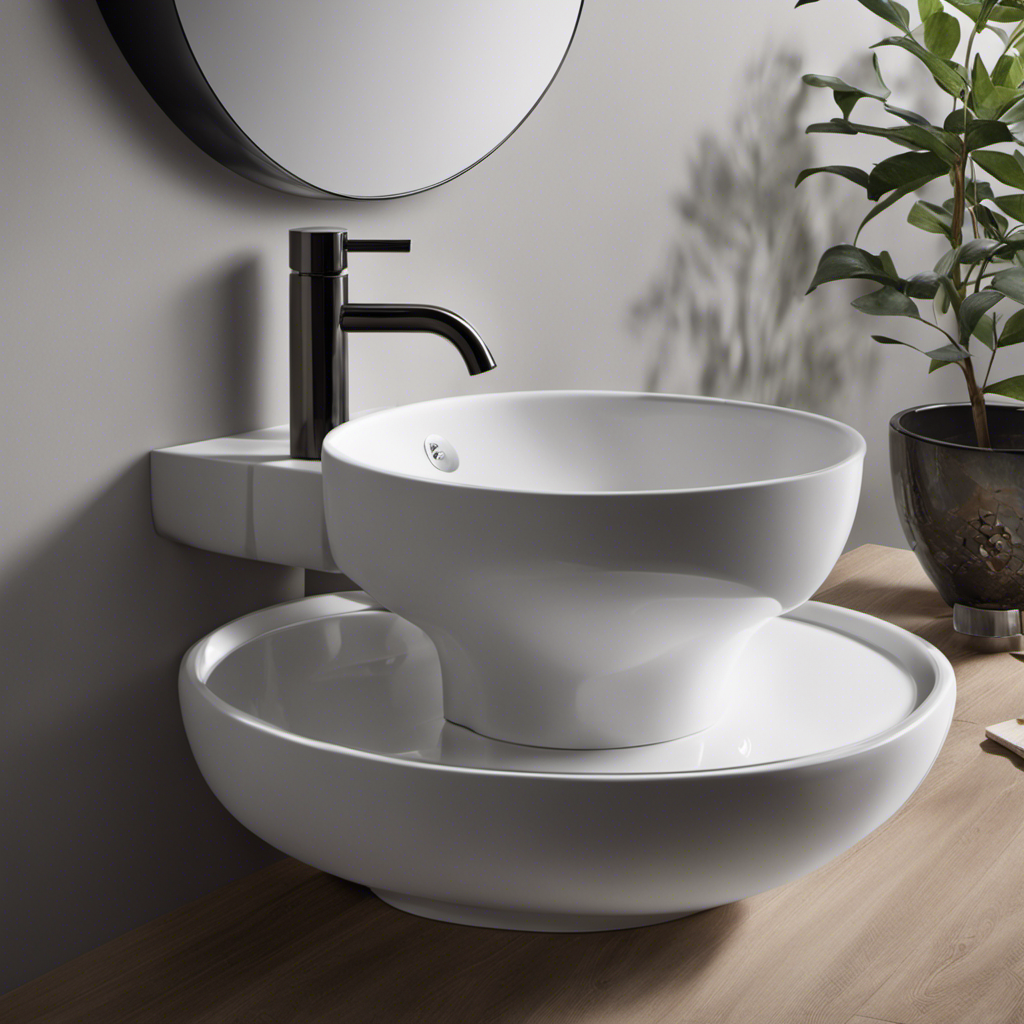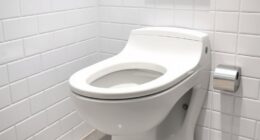As I stand in the bathroom, gazing at the porcelain throne, my eyes are drawn to the mysterious space behind it.
The back of the toilet, a hidden realm of pipes and mechanisms, holds the key to its functionality.
In this article, I will delve into the depths of this enigmatic chamber, exploring its components and purpose.
Join me on this journey as we unravel the secrets of what is commonly known as the tank, and discover the inner workings that make our daily rituals possible.
Key Takeaways
- The back of the toilet is called the toilet tank.
- Common materials for toilet tanks include ceramic, plastic, and stainless steel.
- The toilet tank houses several important components such as the fill valve, flush valve, flapper, and float.
- The toilet tank is responsible for storing and supplying water for flushing, regulating water level and pressure, and controlling the refill process after each flush.
Definition of the Toilet Tank
The toilet tank is where the water is stored before it is flushed. It plays a crucial role in the functioning of a toilet.
When it comes to toilet tank materials, there are a few options available. The most common material used is ceramic, which is durable and easy to clean. Another option is plastic, which is lightweight and affordable. Some high-end toilets even have tanks made of stainless steel, which is known for its strength and corrosion resistance.
As for toilet tank installation, it is a relatively straightforward process. It involves connecting the tank to the bowl and attaching the necessary components like the fill valve and flush valve. Proper installation is essential to ensure the tank operates efficiently and effectively.
Components of the Toilet Tank
Take a look at the components inside the tank, like the fill valve and flush valve. These parts are essential for the proper functioning of the toilet tank.
Here are four key components to be aware of:
-
Fill Valve: This valve controls the flow of water into the tank after each flush. It is responsible for refilling the tank to the correct water level.
-
Flush Valve: The flush valve is responsible for releasing water from the tank into the toilet bowl when the toilet is flushed. It ensures a strong and efficient flush.
-
Flapper: The flapper is a rubber seal that covers the flush valve. It lifts when the toilet is flushed, allowing water to flow into the bowl.
-
Float: The float is connected to the fill valve and is responsible for regulating the water level in the tank. When the water reaches a certain level, the float signals the fill valve to shut off.
Understanding these toilet tank parts and their functions is crucial for troubleshooting and maintaining the proper operation of your toilet.
Purpose of the Toilet Tank
To understand the purpose of the toilet tank, it’s important to know about its key components and how they work together.
The toilet tank is a crucial part of the toilet system, serving multiple functions that are essential for its proper operation. The main function of the toilet tank is to store and supply water for flushing. When the toilet is flushed, water from the tank is rapidly released into the bowl, creating a forceful flow that carries away waste.
Additionally, the tank is responsible for regulating the water level and pressure inside the bowl, as well as controlling the refill process after each flush. Overall, the toilet tank plays a vital role in maintaining the functionality of the toilet and ensuring effective waste removal.
Now, let’s move on to discussing common problems with the toilet tank.
Common Problems With the Toilet Tank
One of the most common issues with the toilet tank is a leaky flapper, which can cause water to continuously flow into the bowl. This can lead to water wastage and higher water bills. To address this problem, there are several techniques you can try:
- Check the flapper for any signs of damage or wear and tear. Replace it if necessary.
- Adjust the chain connecting the flapper to the flushing handle to ensure a proper seal.
- Clean the flapper and the surrounding area to remove any debris or mineral buildup that may interfere with its proper functioning.
- Consider installing a dual-flush system to reduce water usage and prevent leaks.
Regular maintenance and cleaning of the toilet tank can help prevent leaks and ensure its optimal performance. By addressing these common problems promptly, you can save water and money while keeping your toilet in good working condition.
Maintenance Tips for the Toilet Tank
Regularly cleaning and inspecting the toilet tank can help prevent issues and keep it functioning efficiently. It is important to maintain the cleanliness of the tank to avoid any blockages or unpleasant odors. In addition, adjusting the water level in the tank is crucial for optimal performance. By ensuring that the water level is set correctly, you can prevent any potential leaks or overflow problems. To help you with the maintenance of your toilet tank, here is a simple table outlining the steps for cleaning and adjusting the water level:
| Cleaning Steps | Water Level Adjustment Steps |
|---|---|
| 1. Turn off the water supply | 1. Locate the water level adjustment screw |
| 2. Flush the toilet to empty the tank | 2. Turn the screw clockwise to decrease the water level |
| 3. Remove any debris or sediment | 3. Turn the screw counterclockwise to increase the water level |
| 4. Use a toilet brush and cleaner to scrub the tank | 4. Flush the toilet and check the water level |
Frequently Asked Questions
How Does the Back of the Toilet Tank Affect the Flushing Mechanism?
The water level in the back of the toilet tank affects the flushing mechanism. It can be adjusted to ensure proper water flow. The flapper valve plays a crucial role in the flushing mechanism by controlling the release of water from the tank.
What Are Some Signs That Indicate a Problem With the Back of the Toilet Tank?
When it comes to indicating problems with the back of the toilet tank, keep an eye out for signs like toilet tank leaks and fluctuating water levels. These could signify issues that require attention.
Can the Back of the Toilet Tank Be Customized or Decorated?
Yes, the back of the toilet tank can be customized or decorated. There are various options available, such as adhesive decals, paint, or even adding shelves for storage. It’s a great way to personalize your bathroom.
Is It Necessary to Clean the Back of the Toilet Tank Regularly?
Regular cleaning of the back of the toilet tank is essential for maintaining proper hygiene and preventing the buildup of bacteria. It can be challenging to reach, but using a long-handled brush or a mixture of vinegar and water can help.
Are There Any Safety Precautions to Consider When Handling the Back of the Toilet Tank?
When handling the back of the toilet tank, it is important to follow proper safety measures. This includes wearing gloves, using caution when removing the lid, and avoiding any contact with the water or internal mechanisms.
Conclusion
In conclusion, the toilet tank, also known as the back of the toilet, plays a crucial role in the functioning of the toilet. Its main purpose is to hold and store water that is used for flushing.
Understanding the components of the toilet tank and common problems associated with it can help in its proper maintenance.
By investigating the truth of the theory that certain toilet tank designs are more efficient than others, we can gain a deeper understanding of how to optimize water usage and improve overall toilet performance.










